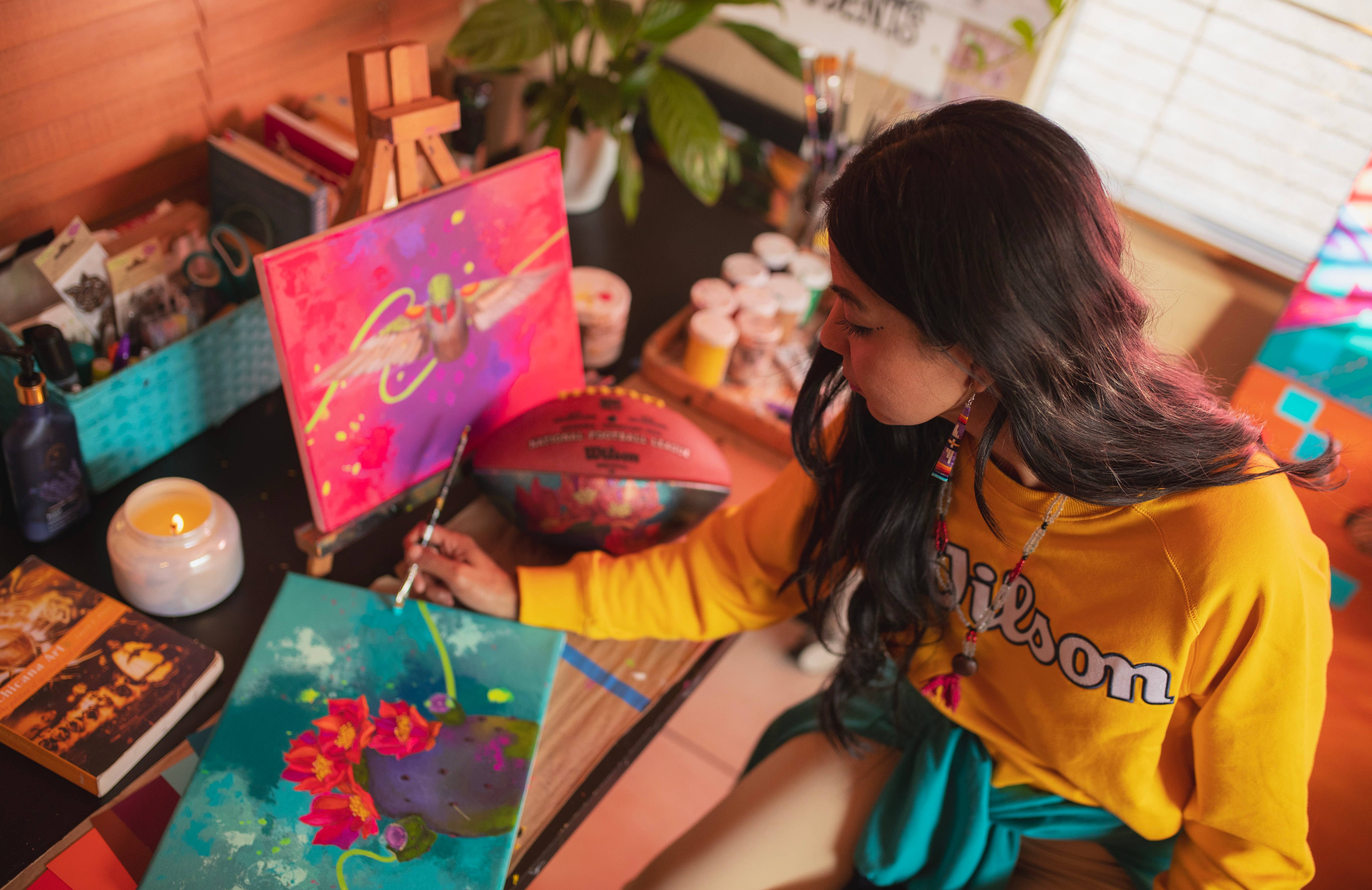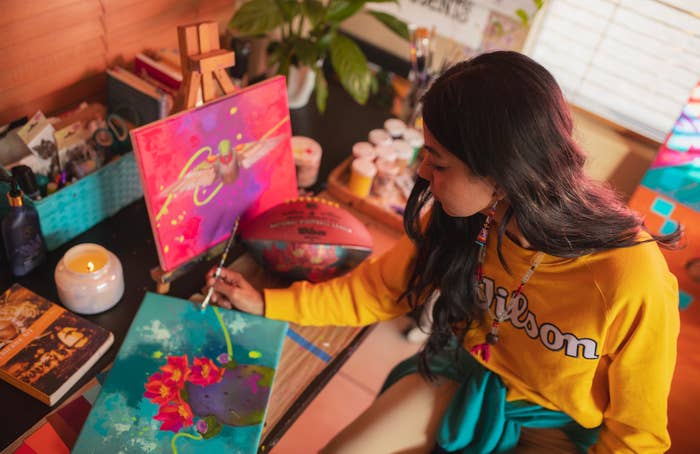
Undoubtedly the biggest sports day of the year in America, the Super Bowl also provides unique opportunities for countless people off the field. Of course there is the Super Bowl halftime show, the attention-grabbing commercials, and the countless apparel collaborations surrounding the big day, but the NFL also provides communities and local artists with the opportunity to represent themselves on an incredibly large scale as well.
This year, the city of Phoenix will host Super Bowl LVII, and Arizona-based artist Lucinda Hinojos has been selected to do a mural for the game as well as design the NFL’s special edition tickets. On top of that, Hinojos has worked on a collaboration with Wilson, designing a special iteration of “The Duke,” a nickname for the NFL’s game ball that was revived in 2005 (originally being used from 1941–1970).
When looking for inspiration to design the ball, Hinojos looked to her larger mural and ticket paintings and chose specific elements from it to emphasize. The Duke’s art features two key design elements, a hummingbird with diamonds representing the 22 Indigenous tribes in Arizona, and a set of flowers used as medicine.
Inspired by her journey, culture, and heritage, Hinojos’ work with the NFL marks the first time that a Chicana and Indigenous artist has been selected for such a large-scale project with the league. Her specially designed ball is slated to release on Feb. 9 for $150.
Ahead of the Super Bowl, we caught up with Hinojos to discuss her work with Wilson and the NFL. This conversation has been condensed for clarity.
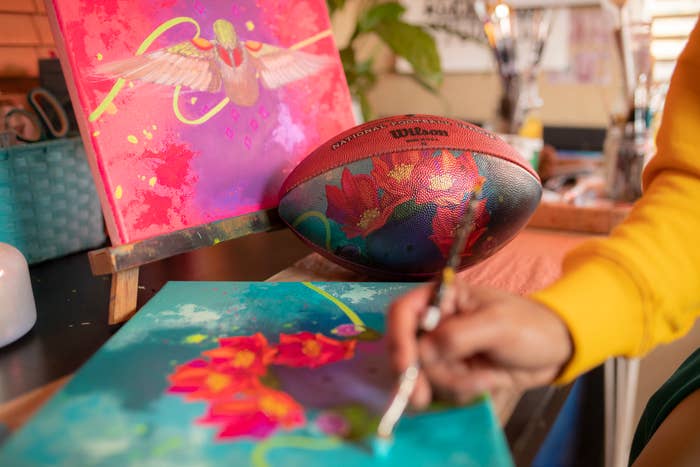
Can you start with a very top-level description of what it’s been like partnering with Wilson and the NFL on these Super Bowl projects?
It’s hard to say in words. It’s a feeling, it’s an energy, and it’s been heavy, but it’s a good heavy. Meaning, to me, doing this project with Wilson and the NFL is more than just a design, more than just a mural, more than just a painting. The fact that Wilson reached out and they had no idea that I was already working with the NFL for the Super Bowl just validates that it was supposed to happen. There is no coincidence. Like I’ve been saying in other interviews, it’s the bigger purpose in itself that these things are happening. There’s synchronicities that are happening. It’s been pretty exciting to do both projects because what I did with the Wilson football is inspired by the painting, and I kind of just took elements from the painting and zoomed in specific elements and put them on the football.
If you look at the football, you see the hummingbird. And I’ve had such a connection to the hummingbird since I was a little girl. And then to the nopales, the cacti, these are things that you see in the land. I spend time out in Salt River, the tribal site, and these things you’ll see on the land. And to us, to native people, we see them as medicine and teachers. And so I wanted to incorporate that into the painting. And so with that, I carried on the storyline and put them in the football.
How much does it mean for you to be able to represent your culture in these collabs and express yourself and your Indigenous roots in that way?
It means a lot to me because representation is needed. When I first accepted the job, I told the NFL that when I come in these spaces, I never come alone. I walk with my ancestors. I bring my community, and I bring my family. And that’s exactly what I did with this project. From my videographers to photographers, to muralists, to my assistants, and to the team project managers, I hired people that are all Indigenous and brown. And that’s how I walk in these spaces. It’s important for that representation because I am paving the way for the future generations for the kids on the reservation and for these little morenitas, these morenas who don’t know that it’s possible for them to be here as well.
Growing up, I didn’t see brown Indigenous women on walls. I saw blonde hair, blue eyes. And so now that I’m… Part of the work that I do is I’m not just a muralist. I’m a mother. I’m a community organizer and activist. But when I do this work, I don’t need to put a fist in the air to be radical. Painting this work is a form of radicalization in itself because I am brown and because I’m Indigenous. Not too long ago, our people were not able to say our prayers and have our ceremonies and paint these things on walls. So it’s a privilege for me to be here, and it’s important for me to do this work. And I think that’s what makes everyone so proud —our community, our Indigenous community, our brown communities—because it feels like, from the comments I’ve received, they have expressed that it feels like they’re being seen for the first time. And that makes me really proud to know that they’re proud.
I watched the promotional video that you put out with the NFL, and it seems like football is also something that’s very important to you and your family. Does that make working on these projects even more meaningful to you?
Oh yeah, absolutely. My kids are here with me right now. I mean, the other day, it was upsetting to see the Cowboys lose, but I couldn’t even watch the TV because the kids were standing in front of the TV. But growing up, the boys played Pop Warner. And as a single mom, I needed help. And so that’s kind of what triggered this whole art journey is because I was trying to do a side hustle and make that extra buck and put the boys in football. Look what happened. Now, I’m here working with the NFL and the kids are actually standing with me here…. And it’s emotional for me because, even my son, Nathaniel, he loves football, man. He knows about almost every player, and he’s coached me through this because it hasn’t been easy.
It’s been hard painting the painting in 14 days and doing a massive mural in just three weeks. But my kid, my son, Nathaniel, has been standing side by side with me, painting with me, helping but also encouraging me and kind of going back to the sport of football, and telling me how these NFL players and what it was like for them when they got drafted and all the stress and everything that they went through at the beginning. And he reminded me, like, “Now, you’re here, Mom. Now, you’re going through what the football players go through when they first get drafted.” So I’m like, “Oh my God, it’s a lot.”
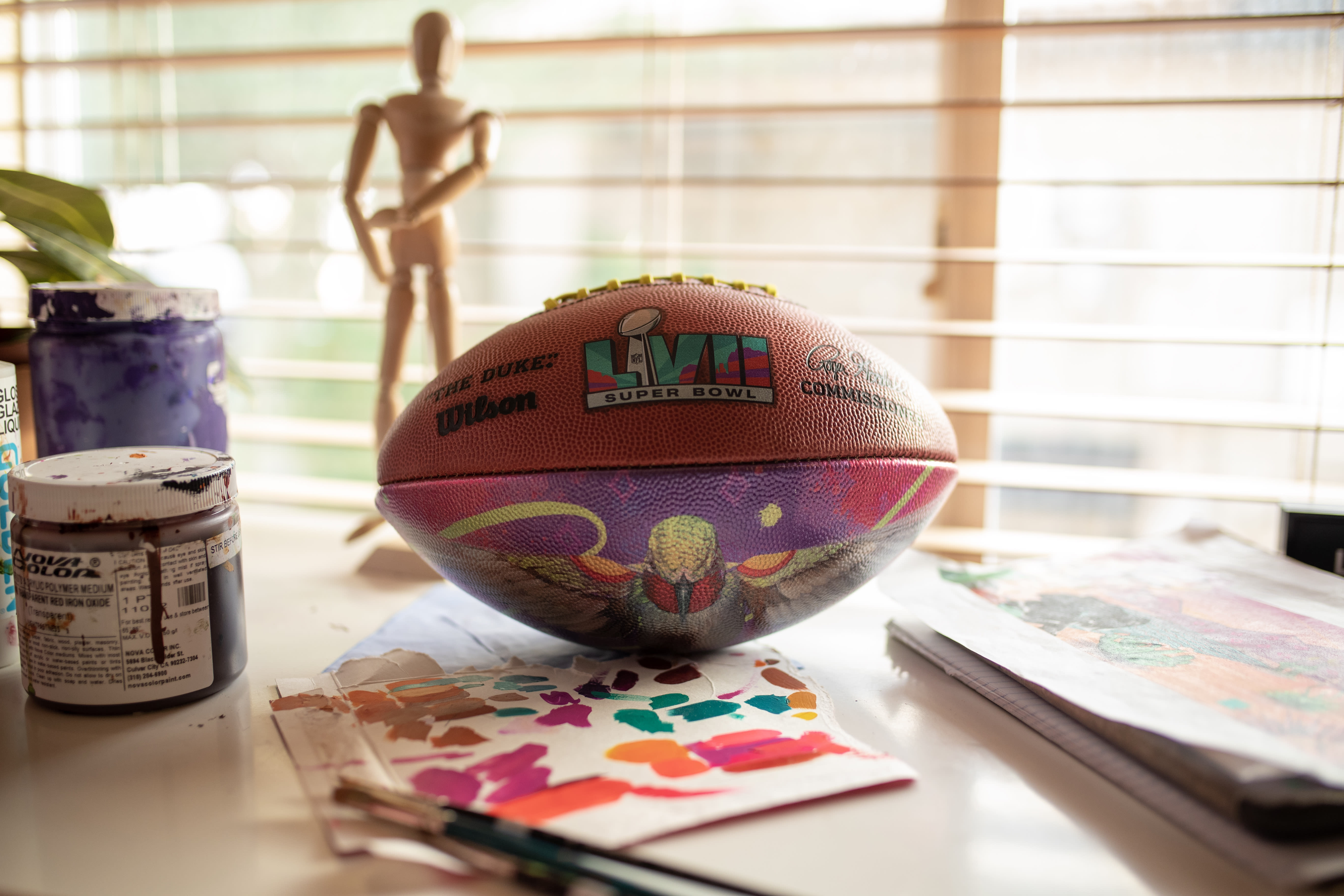
You started to touch on it a little bit earlier, but can you specifically break down the design that you created for the football?
So the elements that I incorporated in the football are a second part of the Super Bowl seam art, which includes the hummingbird. And behind the hummingbird are these diamonds. And in the painting, I put the diamonds to represent stars and to represent our 22 tribes that are here in Arizona. And then the nopales are on the other side you have, which is medicine, and also they carry medicine in our foods. And I wanted to carry those elements into this football, but also the colors. So I’m hearing that my color theory’s going to talk. Everybody’s been really excited about the bright magenta, the pinks, and the oranges and the turquoise and the purples. And for me, I’ve started to experience and learn from being a public artist and being in the streets and painting murals. I’ve seen people’s reactions to the bright colors.
And there’s an energy shift that happens. So when you see an orange or a pink, you can be in a grumpy mood, but when you come across a wall that has bright colors, it shifts you. It shifts that energy in you. I’ve seen it happen with my own eyes where somebody’s walking down the street and they were cursing and yelling and they stopped. The mural with bright colors stopped them in their tracks and they looked up and they smiled. And they’re like, “Oh wow, you did that?” I kind of laughed because I actually saw it happen multiple times. And so I kind of wanted to carry that same energy into the painting and to the football, and so that’s why you see these colors.
When you’re designing something like this for a football, is it difficult to plan for the strange shape of a football? Obviously the ticket and the mural are a bit more standardized designs. But design for a football, are there certain challenges that come with that?
It’s not really a challenge. It pushed my creative process. As artists, sometimes we can stick to the murals and we can stick to the canvas, but something like this, it pushes your creativity. And so it allowed me to break through and work with a plan and paint for a different medium. And so it was pretty cool because, as muralists, what we do is you get a big wall and you just pick one image and you blow it up and you paint it big.
And that’s kind of how the process I did for football is you’re going to have… I can’t paint a whole painting, but I can do one element. And that’s what I did with the hummingbird. I just took one element, painted it for each panel, and so it came on great. I was floored. I thought, “Man, it’s the prettiest football I’ve ever seen before.”
It’s an art piece. It’s seriously an art piece. I was like, “I don’t know if anybody’s going to play football with it.” I would have it framed or in a box.
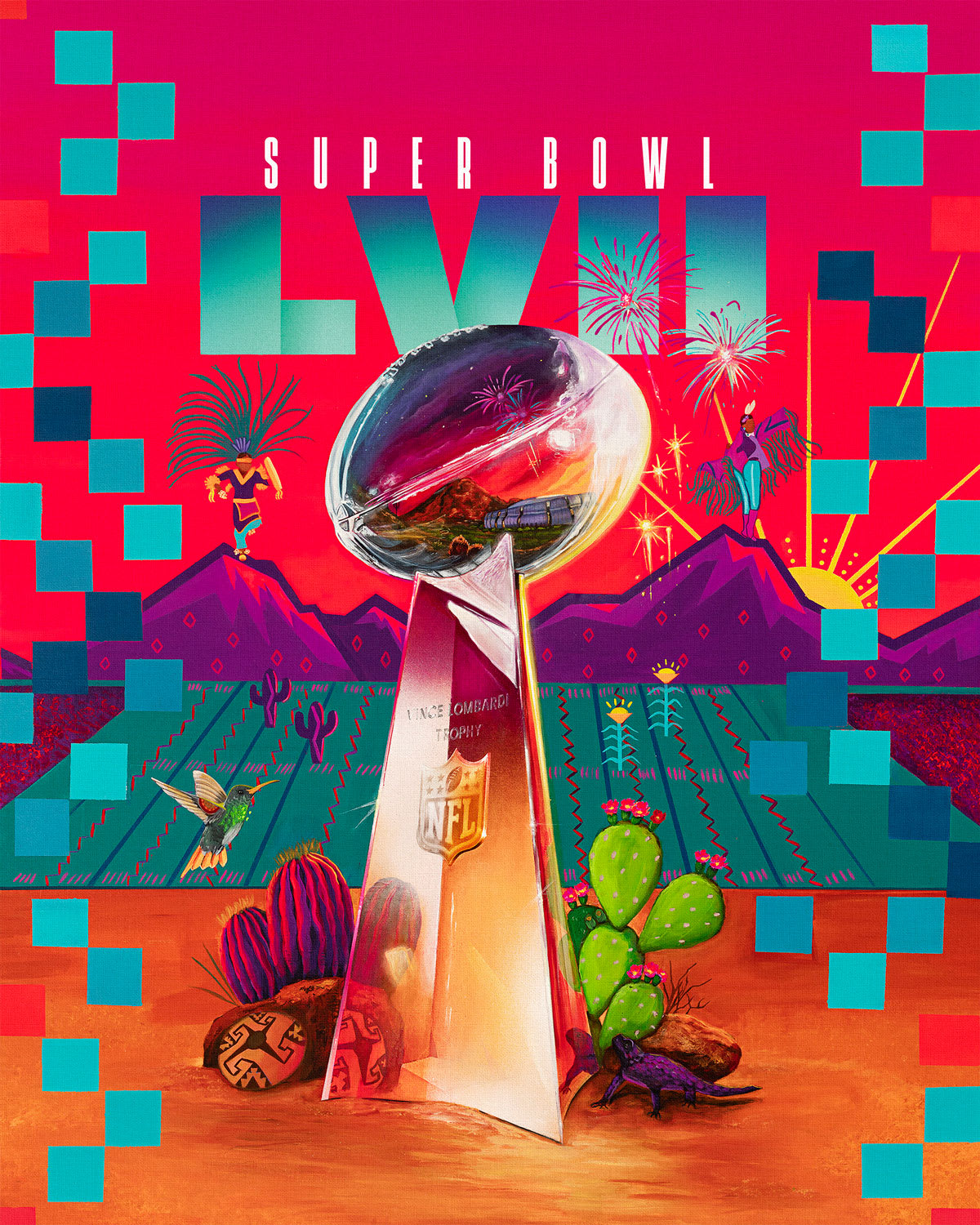
How much does hosting the Super Bowl mean to a community like Phoenix, being as diverse as it is?
You know what? Another great thing about the Super Bowl ticket, it’s that centerpiece. That’s what it is for me, where it doesn’t matter what kind of cultural background you have, we get to celebrate in this one space. We get to celebrate it together. There’s no politics. There’s no this and that. We get to celebrate it, the game of football, in this one place together. And I always say, “You know what? We don’t always look at each other, and that’s what this is about.”

